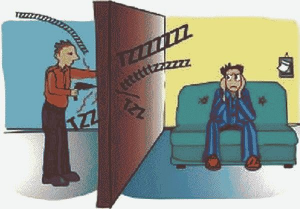 July 2023
July 2023
Among the drawbacks of being at home all day is unwanted noise. Through open windows come the sounds of kids yelling, barking dogs, leaf blowers and construction. High-rise communities must also contend with noise from neighbours internally through walls, ceilings and floors which can interrupt quiet relaxation or working sessions, phone calls and Zoom meetings. There has never been greater demand for quiet.
Unwanted sounds can be reduced or softened with solutions ranging from inexpensive design tweaks to extensive renovations.
Most noise complaints in high-rise buildings concern upstairs neighbors. There is typically solid concrete separation between units which transmits sound. A suspended ceiling can provide room for sound absorption material. Low-profile recessed ceiling lights reduce sound penetration. A similar approach can be used by applying specialized wall panels from floor to ceiling. Such an extensive and costly renovation is beyond what most require. Before providing simpler solutions, it helps to understand the basics of sound.
Understanding Sound
Sounds are classified by frequency. Low-frequency sounds, the hardest to contain, include bass from music, furniture sliding across a floor and footfalls. They permeate doors, walls and windows. High-frequency sounds are easier to disrupt because they’re vibrating so quickly.
It is mid-range frequency sounds that are most concerning, including human speech. They accumulate, bounce around and reflect off the floor and ceiling. Fabric and books are inexpensive techniques for absorbing much of the unwanted high- and mid-range frequency sounds.
Inexpensive Sound Control Measures
Rugs prevent mid-frequency sounds from bouncing off a hard surface. Books on walls, spines turned inward so pages face out absorb mid-frequency sounds. Uneven heights and thicknesses work best at breaking up sound waves and creating a softer sound. Where there are windows, consider drapes.
Another trick comes from home recording studios. Put cardboard egg cartons on the wall. The cardboard pockets will absorb a large portion of those mid-frequency sounds. A more professional approach is to purchase acoustic panels. Each is two inches thick and four feet by two feet. They are lightweight and easy to attach to a wall. Covering panels in fabric make them decorative.
Sound sneaks through cracks and gaps, so energy-efficient features serve a dual purpose. Door sweeps, weatherstripping and storm windows all help to keep out sounds.
For sounds that enter through an open window, ocean noise videos are more than calming. Ocean waves have a full spectrum of sound waves so can mask many noises.
Living near others requires dealing with their noise. Turning your home into a quiet refuge from most sounds will calm the nerves and reduce stress.
Find Vendors in these Related Categories
- Accessibility Products
- Blinds, Shades & Balcony Flooring
- Contractors - Electrical
- Contractors - General
- Contractors - Mechanical
- Design Services
- Flooring
- Furniture
- Home Finishing
- Home Services & Automation
- Lighting Services & Suppliers
- Painting
- Renovation Services
- Restoration Services
- Sound Control
- Window Replacement/Repair







